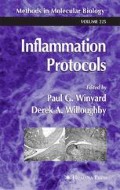Abstract
Wound healing in adult mammals proceeds by a series of overlapping, highly coordinated events. The sequence in dermal wound repair, which is principally analogous in other anatomical locations, starts with the arrest of hemorrhage, followed by an inflammatory response; reepithelialization of the wound; formation of granulation tissue within the wound space and finally the production of a scar (1,2).
Access this chapter
Tax calculation will be finalised at checkout
Purchases are for personal use only
References
Clark, R. A. F. (1996) Wound repair overview and general consideration, in The Molecular and Cellular Biology of Wound Repair, (Clark, R. A. F., ed.), Plenum, New York, pp. 3–35.
Ferguson, M. W. J. and Leigh, I. M. (1998) Wound Healing, in Rook/Wilkinson/Ebling, Textbook of Dermatology 6th Edition (Champion, R. H., Burton, J. L., Burns, D. A., and Breathnach, S. M., eds.), Blackwell Science, Oxford, U.K., pp. 337–356.
Cowin, A. J., Brosnan, M. P., Holmes, T. M., and Ferguson, M. W. J. (1998) Endogenous inflammatory response to dermal wound healing in the fetal and adult mouse. Dev. Dyn. 212, 385–393.
Ferguson, M. W. J., Whitby, D. J., Shah, M. J., Siebert, J. W., and Longaker, M. T. (1996) Scar formation: the spectral nature of fetal and adult wound repair. Plast. Reconst.Surg. 97, 854–860.
Cherry, G. W., Hughes, M. A., Leeper, D. J., and Ferguson, M. W. J. (2001) Wound Healing, in Oxford Text Book of Surgery 2nd Edition (Morris, P. J. and Wood, W. C., eds.) pp. 129–159
Agren, M. S., Eaglstein, W. H., Ferguson, M. W. J., Harding, K. G., Moore, K., Saarialho-Kere, U. K., et al. (2000) Causes and effects of the chronic inflammation in venous leg ulcers. Acta. Derm. Venerol. 210, 3–17.
McCallion, R. L. and Ferguson, M. W. J. (1996) Fetal wound healing and the development of antiscarring therapies for adult wound healing, in The Molecular and Cellular Biology of Wound Repair (Clark, R. A. F., ed.), Plenum, New York, pp. 561–600.
Ashcroft, G. S., Horan, M. A., and Ferguson, M. W. J. (1997) The effects of ageing on wound healing: immunolocalisation of growth factors and their receptors in a murine incisional model. J. Anat. 190, 351–365.
Ashcroft, G. S., Horan, M. A., and Ferguson, M. W. J. (1998) Aging alters the inflammatory and endothelial cell adhesion molecule profiles during human cutaneous wound healing. Lab. Invest. 1, 47–58.
Ashcroft, G. S., Dodsworth, J., van Boxtel, E., Tarnuzzer, R. W., Horan, M. A., Schultz, G. S., et al. (1997) Estrogen accelerates cutaneous wound healing associated with an increase in TGF-β1 levels. Nat. Med. 3, 1209–1215.
O’Kane, S. and Ferguson, M. W. J. (1997) Transforming growth factor betas and wound healing. Int. J. Biochem. Cell. Biol. 29, 63–78.
Herrick, S. E., Sloan, P., McGurk, M., Freak, L., McCollum, C. N., and Ferguson, M. W. J. (1992) Sequential changes in histologic pattern and extracellular matrix deposition during the healing of chronic venous ulcers. Am. J. Pathol. 141, 1085–1095.
Ferguson, M. W. J., Herrick, S. E., Spencer, M. J., Shaw, J. E., Boulton, A. J., and Sloan, P. (1996) The histology of diabetic foot ulcers. Diabet. Med. 13, S30–S33.
Morris, D. E., Wu, L., Bolton, L., Roth, S. I., Ladin, D. A., Mustoe, T. A. (1997) Acute and chronic animal models for excessive dermal scarring: quantitative studies. Plast. Reconstruct. Surg. 100, 674–681.
Sullivan, T. P., Eaglstein, W. H., Davis, S. C., and Mertz, P. (2001) The pig as a model for human wound healing. Wound Rep. Regener. 9, 66–76.
Leenen, P. J. M., de Bruijn, M. F. T. R., Voerman, J. S. A., Campbell, P. A., and van Ewijk, W. (1994) Markers of mouse macrophage development detected by monoclonal antibodies. J. Immunol. Methods 174, 5–19.
Charles, D., Williams, K., Perry, L. C., Fisher, J., and Rees, R. S. (1992) An improved method of in vivo wound disruption and measurement. J. Surg. Res. 52, 214–218.
Clugston, P. A., Vistnes, M. D., Perry L. C., Maxwell, G. P., and Fisher, J. (1995) Evaluation of silicone-gel sheeting on early wound healing of linear incisions. Ann. Plast. Surg. 34, 12–15.
Author information
Authors and Affiliations
Editor information
Editors and Affiliations
Rights and permissions
Copyright information
© 2003 Humana Press Inc.
About this protocol
Cite this protocol
Tomlinson, A., Ferguson, M.W.J. (2003). Wound Healing. In: Winyard, P.G., Willoughby, D.A. (eds) Inflammation Protocols. Methods in Molecular Biology, vol 225. Humana Press. https://doi.org/10.1385/1-59259-374-7:249
Download citation
DOI: https://doi.org/10.1385/1-59259-374-7:249
Publisher Name: Humana Press
Print ISBN: 978-0-89603-970-4
Online ISBN: 978-1-59259-374-3
eBook Packages: Springer Protocols

